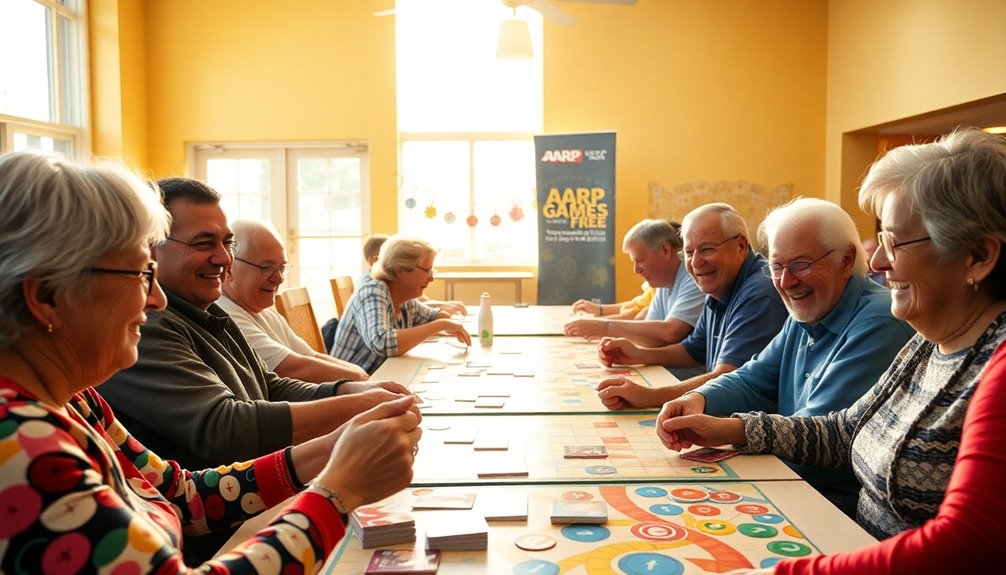You can enjoy a variety of free AARP games that are not just fun, but also brain-boosting! Engage your mind with daily trivia challenges in Right Again! Trivia, or relax with classic favorites like Solitaire and Bubble Shooter. These games can enhance your memory and improve problem-solving skills. Plus, you'll find exclusive access to over 40 member-only games, including nostalgic crosswords and sports trivia. Engaging in multiplayer games also helps you connect with others and promote teamwork. Ready to explore the exciting world of AARP games? There's so much more to discover!
Key Takeaways
- AARP offers a selection of over 40 games exclusively for members, providing free access to fun activities that stimulate the mind.
- Engage with daily trivia challenges through Right Again! Trivia to boost knowledge and cognitive skills while having fun.
- Enjoy casual gameplay with games like Bubble Shooter and Classic Solitaire, perfect for relaxation and mental engagement.
- Participate in multiplayer games to foster social connections and teamwork, enhancing both enjoyment and emotional well-being.
- Earn up to 300 AARP Rewards Points daily through gameplay, adding an extra incentive to enjoy these brain-boosting activities.
Popular Games Overview
When you explore AARP's gaming options, you'll find a range of popular games designed to keep you engaged and entertained. AARP caters to various interests with games like Right Again! Trivia, where you can test your knowledge through daily challenges. This game not only empowers you to learn but also keeps your mind sharp.
If you're looking for something more casual, Bubble Shooter and Classic Solitaire offer timeless fun. With Classic Solitaire, you can challenge yourself with different levels of difficulty, making it a perfect way to unwind while still stimulating your brain.
For those who enjoy a bit of adventure, Zoo Boom introduces a new three-style match game that appeals to all ages, promoting cognitive engagement as you strategize your moves.
Plus, as you play these popular games, you can earn up to 300 AARP Rewards Points daily, incentivizing your gameplay and enhancing your vocabulary with Word Wipe.
With such a variety of engaging activities, AARP truly empowers people to enjoy their leisure time while boosting mental acuity. So jump in and discover your new favorite game today! Whether you prefer puzzles, trivia, or social games, there’s something for everyone. One of the highlights is the AARP Daily Crossword Puzzle Challenges, which not only test your vocabulary but also help keep your mind sharp. Join a community of fellow enthusiasts and see how you can enhance your cognitive skills while having fun!
AARP Exclusives for Members

AARP members enjoy exclusive access to a variety of engaging games that cater to diverse interests and skill levels. Among the favorites is AARP Right Again! Trivia, where you can test your knowledge across multiple topics.
If you're a sports fan, you'll love the specialized AARP Right Again! Trivia Sports, focusing on all things athletic. For crossword enthusiasts, AARP Throwback Thursday Crossword offers a nostalgic twist, featuring themes from the past.
Additionally, you can immerse yourself in AARP Rewards Mahjongg Dimensions, which comes with unique features designed to enhance your gameplay experience.
With over 40 games available exclusively to AARP members, these options not only provide fun and brain-boosting activities but also foster community engagement. You can connect with fellow players, challenge friends, and share your gaming experiences.
These exclusive offerings guarantee that you're not just playing games; you're also building connections and enjoying a vibrant community. By participating in these activities, you'll find a fantastic way to keep your mind sharp while having a great time.
Benefits of Brain Games

Playing games isn't just about fun; it also offers significant benefits for your brain health. Engaging in brain games empowers people to choose activities that stimulate their minds and keep them sharp. Here are some key benefits of brain games:
- Enhance Memory: Regularly playing brain games has been shown to boost your ability to remember information.
- Lower Dementia Risk: Stimulating cognitive functions through brain games can lower the risk of dementia, promoting mental agility.
- Improve Problem-Solving Skills: Daily participation in these games hones your problem-solving abilities, which is essential for maneuvering everyday challenges.
- Promote Social Interaction: Multiplayer games not only provide a fun and enjoyable experience but also foster social connections that can reduce stress and enhance emotional well-being.
Incorporating a variety of game types, like crosswords or Sudoku, keeps your mind challenged and engaged.
The laughter and enjoyment you experience during gameplay further contribute to overall brain health, making your gaming sessions not just beneficial but enriching.
Game Genres Available

Explore a variety of game genres available through AARP that cater to a wide range of interests and skill levels. As a nonpartisan organization that empowers you, AARP offers engaging options to keep your mind sharp and entertained.
If you're a trivia buff, immerse yourself in trivia games like AARP Right Again! Trivia and AARP Right Again! Trivia Sports, which challenge your knowledge across multiple categories.
For those who enjoy strategic thinking, puzzle games like Word Wipe and Rewards Mahjongg enhance cognitive skills while providing hours of fun.
Card game enthusiasts can indulge in classic favorites, such as Solitaire, or explore modern variations that test your strategic prowess.
If you're looking for a more relaxed gaming experience, bubble games like Bubble Shooter deliver entertainment suitable for casual gamers of all ages.
With such a diverse selection of game genres available, you're bound to find something that piques your interest and keeps your brain engaged.
Community Engagement Through Games

Games offer a fantastic avenue for fostering community engagement, bringing people together through shared experiences and activities. AARP's gaming platform provides a unique opportunity for you to enhance social interaction and strengthen bonds with others in your community.
Here are some key benefits of engaging through games:
- Teamwork: Participate in multiplayer puzzles and trivia competitions that require collaboration, developing your teamwork skills while having fun.
- Emotional Well-Being: Enjoying games with others can lead to lasting friendships, contributing to your overall emotional well-being and happiness.
- Social Interaction: Discuss strategies and share knowledge during gameplay, enriching your social ties and creating a supportive environment.
- Volunteer Opportunities: Join community-focused gaming events that often incorporate volunteer activities, allowing you to give back while connecting with others.
Frequently Asked Questions
Are There Any Free Brain Games for Seniors?
Yes, there are plenty of free brain games for seniors! You can enjoy trivia, word puzzles, and card games that enhance cognitive skills, making it fun while boosting your memory and problem-solving abilities.
Are AARP Games Free?
You'll feel like a genius playing AARP games! While many are free, some exclusive games require a membership. For just $9 a year, you gain access to over 40 fantastic games that boost your brainpower!
Is Staying Sharp on Aarp Free?
Yes, Staying Sharp is free for AARP members. You can access various interactive games designed to enhance cognitive skills. While some premium features may cost extra, plenty of engaging activities are available at no charge.
Why Are AARP Games Not Working?
AARP games might not work due to outdated browsers, poor internet connections, or expired memberships. You should check your settings, clear your cache, and verify your membership is active to improve your gaming experience.
Conclusion
In the world of AARP games, you're not just playing; you're sharpening your mind like a sculptor chiseling away at marble. These free, fun activities offer a fantastic way to engage your brain while connecting with others. Whether you're diving into puzzles or exploring new challenges, you'll find something that sparks your interest. So why not jump in? Embrace the joy of gaming and let each session be a step towards mental fitness and community bonding!









